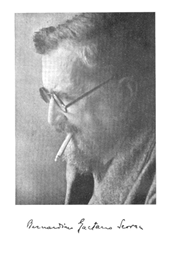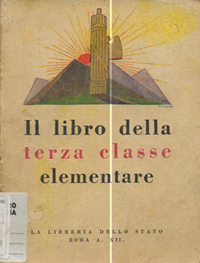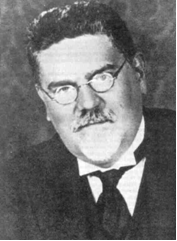 The website is in construction. New files will be uploaded as soon as they are available.
The website is in construction. New files will be uploaded as soon as they are available.
GAETANO SCORZA
Morano Calabro (Cosenza) 1876 - Rome 1939

- Brief scientific biography
- His commitment to Education
- Essential bibliography
- Articles and books on the teaching of mathematics
Brief scientific biography
Bernardino Gaetano Scorza was born in Morano Calabro on 29 September 1876. He completed his studies at the Collegio Nazareno in Rome and at the Pious Schools of the Piarist Fathers in Florence and then enrolled at the University of Pisa. Among his teachers were Eugenio Bertini, Ulisse Dini and Luigi Bianchi, and in 1898 he received his degree (laurea) in mathematics. He was immediately assigned a position as an assistant in analytical and projective geometry in the University of Pisa, and in 1899-1900, through an exchange of assistants agreed upon between Bertini and Corrado Segre, he was an assistant in projective and descriptive geometry at the University of Turin. Once back in Pisa, he reassumed his position as assistant, and earned his habilitation in teaching at the prestigious Scuola Normale Superiore in Pisa. From 1902 to 1912 he taught in secondary schools, more precisely, in technical institutes in Terni, Bari and Palermo.
Having earned his university teaching qualification (libera docenza) in 1907, in 1912 he won the competition for a professorship in projective and descriptive geometry at the University of Cagliari. From here he went to Parma (1913), to Catania (1916), to Naples (1920), and finally to Rome (1934), where he stayed until his death. In the various universities he taught several other courses as well, including that of complementary mathematics, mainly aimed at the preparation of mathematics teachers in secondary schools.
The most important nucleus of Scorza's scientific production regards hyperspatial projective geometry, Abelian functions, the matrixes that he called Riemann matrixes, the theory of algebras and groups. The works of hyperspatial projective geometry fall into the more ample context of the geometry of birational transformations and, extending the results of F. Enriques and E. Castelnuovo, arrive at the complete classification of the multi-dimensional varieties with elliptical curve sections. But the area in which Scorza obtained his most significant results is that of Abelian functions, particularly of singular Abelian functions. In his research he was guided by a particular geometric representation with which all the problems of the existence of singular Abelian functions are reduced to problems of a more elementary type relative to the existence of linear systems of rational homographies of a hyperspace. His masterpiece is a substantial article of 1916 entitled Intorno alla teoria generale delle matrici di Riemann e ad alcune sue applicazioni (Rendiconti del Circolo matematico di Palermo, 41, 1916, 263-380, also in Opere scelte, II, 127- 275).
Beginning in 1921, the principle object of his research was the general theory of algebras, which led him to grapple with problems in number theory and the theory of finite groups. The publication of his authoritative treatise Corpi numerici e algebre dates from that year, in which the general theory of algebras is presented elegantly and systematically, with original contributions.
In 1942 the volume Gruppi astratti was published posthumously, edited by Giuseppe Scorza Dragoni and Guido Zappa.
He was also occupied with questions of political economy and theoretical photogrammetry. A rich group of his publications is closely connected with teaching in secondary schools.
Scorza was a member of many Italian scientific academies and institutes, held numerous offices, and received various awards. In particular, in 1926 he became a member of the Accademia dei Lincei; he was a member of the Consiglio Superiore della Pubblica Istruzione (High Council for Public Instruction) from 1923 to 1932; he was the director of the journal Rendiconti del seminario matematico della R. Università di Roma; he was president of the mathematics committee of the Italian National Research Council (CNR) from 1928 to 1931; he was vice-president of the ICMI from 1932 until his death; and he was a member of the commission for the first state textbook for elementary schools.
His commitment to Education

From these reports, as well as from later articles that touch on this problem, emerges his vision of mathematics teaching, a vision that is shaped by the influence of Felix Klein (SCORZA 1911, 76-80), whose book Elementarmathematik vom höheren Standpunkte aus was reviewed by Scorza (SCORZA 1910). Scorza admired Klein for his research method, his mastery of the most disparate branches of mathematics, his capacity for grasping the even most hidden relationships between them, and for having outlined vast programs of work (SCORZA 1930, 171).
Scorza's vision of mathematics teaching can be summarised in the following points:
- bridge the gap between secondary teaching and university teaching by introducing elements of differential and integral calculus and "the highest theories of elementary geometry ... in conformance with the views that underlie modern geometry and constitute its greatest value and most compelling fascination" (SCORZA 1914, VII);
- coordinate the teaching of mathematics with that of physics and other sciences;
- avoid fanatical purism;
- do not use only one method so as to "close oneself in it as behind iron gates" (SCORZA 1930, 170);
- do not be too tied to textbooks:
"A lesson in mathematics can be a work of art and not a tired repetition of postulates, theorems and corollaries strung one after another with lifeless mechanicalness as the disconnected words of a child's nursery rhyme; but provided that who is giving the lesson appears to the student ... as a very secure master of what he has to say ... so that he presents [each argument] to the students as if it sprang ... bright, spontaneous and new, from the living flow of the discussion" (SCORZA 1930, 174)

Barely two years earlier, at the lecture given for the inauguration of the Mathematics Circle of Catania, Scorza expressed his doubts about the Neo-Idealistic philosophical movement, behind which he seemed to "glimpse a hardly seductive nihilism" (SCORZA 1921, p. 19), and passionately defended the educational, ethical and aesthetic value of mathematics. Taking up the same theme once again in 1923, he explicitly stated that "the philosopher who hasn't had a good education in mathematics pays bitterly for his deficiency" and he maintained the importance of a mathematics teaching which was not "passive or dogmatic" but which availed itself of an "active and heuristic method", developing both the creative imagination as well as an acute critical sense (SCORZA 1923, p. 83).
In laying out the new mathematics programs, he was in any case strongly conditioned by the general outline of the reform. The directives of Fascism and the Neo-Idealistic ideology were opposed to an ample diffusion of scientific culture, and above all to its interaction with other areas of culture: humanistic culture was to constitute the cultural axis of national life, and especially of the schools. The old programs, which provided the teacher with the detailed outline of the subject and with helpful instructions on methodology, were substituted by programs of examinations that indicated the objective, but not the way to achieve it.
During the Fascist regime, Scorza was also the author of the part relative to mathematics of the State textbook for the third, fourth and fifth grades of the elementary schools (SCORZA 1930-1933). Here he tries to begin with the concrete, making reference to the child's limited world; he is attentive to the precision and clarity of the language; he introduces new arguments by starting with one or two examples and only in a second moment does he give, if it is necessary, the rule; he proposes simple problems taken from everyday life.
Essential bibliography
G. SCORZA, Opere scelte, Roma, Ed. Cremonese, 3 voll. 1960, 1961, 1962.
L. BERZOLARI 1939, Gaetano Scorza, Bollettino della Unione Matematica italiana, s. 2, 1, pp. 401-408.
F. SEVERI 1941, L'opera scientifica di Gaetano Scorza, Annali di Matematica pura ed applicata, s. 4, 20, pp. 1-20
G. SANSONE 1977, Scorza Gaetano, in Geometri algebristi, ex-normalisti del periodo 1860-1929, Pisa, Scuola Normale Superiore di Pisa, pp. 13-15, 31.
Publications on the teaching of mathematics
G. SCORZA 1910-1911, (under the pseudonym EX-LANGHAM), Sulla teoria dei numeri reali, Pitagora, 17, pp. 25-28
G. SCORZA 1911a, L'insegnamento della matematica nelle Scuole e negli Istituti tecnici, Bollettino della Mathesis, a. III, pp. 49-80, a p. 69 (abstract in EM 14, 1912, 416-420)
G. SCORZA 1911b, Logica e matematica. Le geometrie non-euclidee in rapporto alla teoria della conoscenza, Annuario della Biblioteca filosofica, 1, pp. 226-227
G. SCORZA 1912a, Sui libri di testo di geometria per le scuole secondarie superiori, Bollettino della Mathesis, a. IV, pp. 235-247(abstract in EM 15, 1913, 427-430)
G. SCORZA 1912b, Prefazione to the Italian translation by G. Fazzari of the book: C. de Freycinet, Dell'esperienza in geometria, Palermo, Reber.
G. SCORZA 1914, Complementi di geometria, I, Bari, Laterza
G. SCORZA 1921, Essenza e valore della matematica, Esercitazioni matematiche, Catania, 1, pp. 1-25, also in Opere scelte, III, pp. 1-23.
G. SCORZA 1922, Intorno al principio di causalità e alle applicazioni della matematica alle scienze sociali, Periodico di matematiche, 4, 2, pp. 1-20, also in Opere scelte, III, pp. 43-60.
G. SCORZA 1923, Il valore educativo della matematica, Esercitazioni matematiche, Catania, 3, pp. 251-273, also in Opere scelte, III, pp. 77-97.
G. SCORZA 1930, La matematica come arte, Atti della 19a riunione della Società Italiana per il Progresso delle Scienze, 13-146, also in Opere scelte, III, pp. 158- 175.
G. SCORZA is also the author of numerous reviews, some of which are of textbooks for secondary schools or books concerned with the training of teachers. Among these we cite the review of F. Klein's Elementarmathematik vom höheren Standpunkte aus, in Bollettino della Mathesis, II, 1910, pp. 130-146, III, 1911, pp. 48-54.
Author
Livia Giacardi
Department of Mathematics
University of Turin - ITALY
livia.giacardi@unito.it
